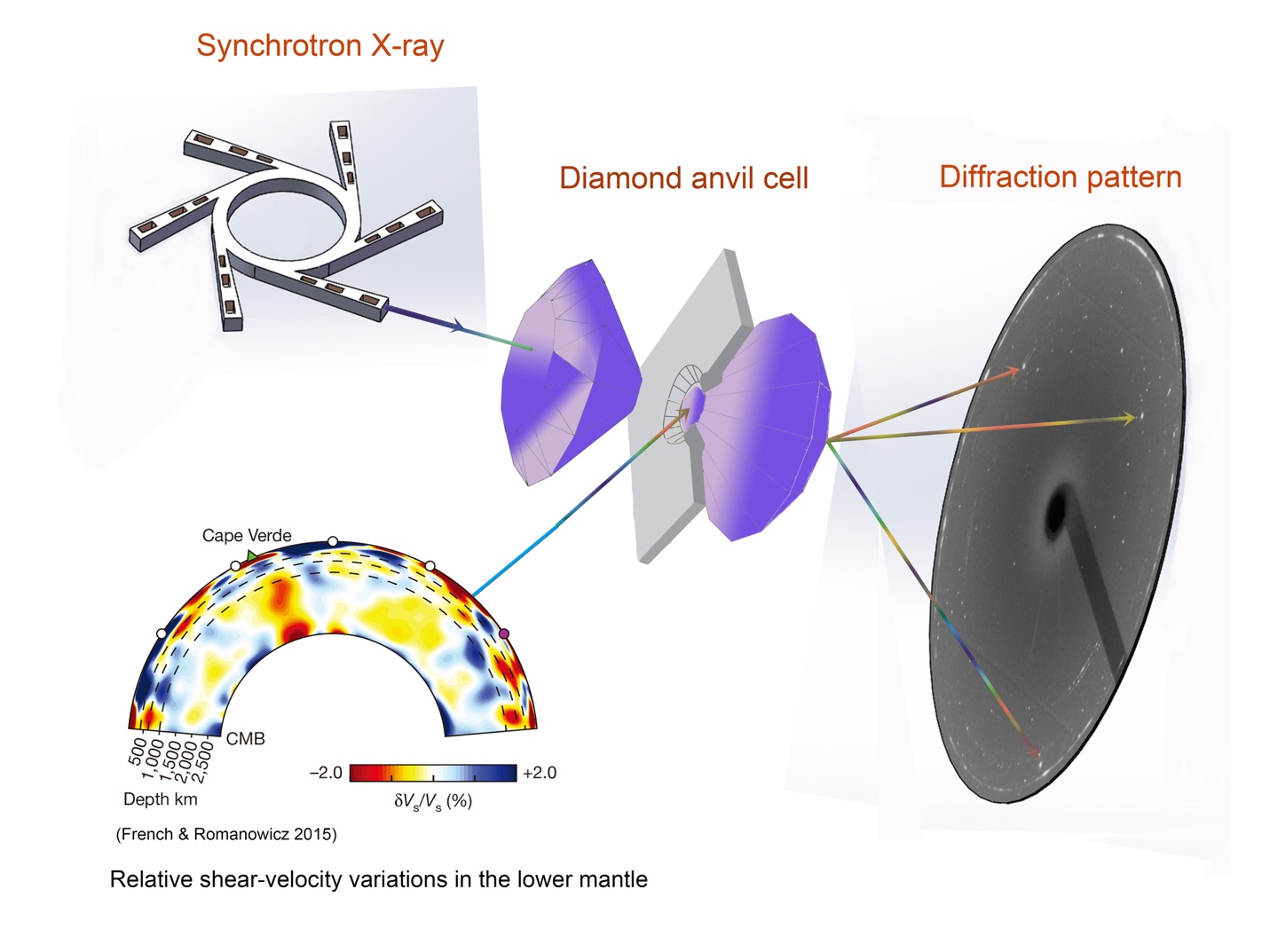Using a laser-heated diamond anvil cell to simulate high-pressure and high-temperature conditions of the Earth’s lower mantle, HPSTAR scientists Ziqiang Yang, Ho-kwang Mao and Li Zhang have obtained iron silicate phases in both perovskite and postperovskite structures stable under conditions of the lower mantle below 1000 km depth. The stability and properties of the iron silicate phases provide crucial information for explaining the lower mantle structure. The paper is published in the PNAS.
The Earth's lower mantle comprises more than half of our planet by volume. The lower mantle ranges from 660 to 2,890 km depth, corresponding to 24 to 136 GPa in pressure. The lower mantle is dominated by bridgmanite — a ferromagnesian silicate phase in the perovskite structure of ABO3, where A and B sites are dominated by Mg and Si —likely making it the most abundant mineral on Earth. Bridgmanite contains about 10 mol% iron silicate. How iron is distributed in the Mg and Si sites of bridgmanite is a key factor controlling the physical and chemical properties of the lower mantle.
To reveal the enigmatic deep interior of the Earth, the HPSTAR team have been investigating the stability and properties of iron silicate in experimental simulations under high-pressure and high-temperature conditions of entire lower mantle. The phase transitions in iron silicates and characterization of the high-pressure phases would provide insights into the behavior of iron in ferromagnesian silicates under the lower mantle conditions.
In fact, the first known phase transition in the upper mantle was discovered in iron silicate. In 1958, Ringwood discovered fayalite Fe2SiO4 olivine–spinel transition, providing key information for understanding the upper mantle structure. In 1971, Mao and Bell discovered the disproportionation of fayalite spinel into mixed oxides as the first known phase transition in the lower mantle region. In this study, iron silicate perovskite was obtained above 60 GPa, corresponding to about 1200 km depth, and then postperovskite above 95 GPa. The first author Ziqiang Yang is a PhD graduate student at HPSTAR, he told us, “To be best of our knowledge, this is the first report of iron silicate perovskite from ferrous iron material under the lower mantle conditions”. Phase transformations of iron silicates are finally resolved over the entire mantle conditions.
The newly discovered iron silicate perovskite has a chemical composition of solid solution 25mol%Fe2O3-75mol%FeSiO3, indicating the occurrence of disproportionation of ferrous iron. Further, ferric iron in the Si site undergoes a high-spin to low-spin transition at pressure corresponding to around 1000 km depth. Such a change has important consequences for interpretation of the lower mantle structure. State-of-the-art seismic-tomography models show considerable shear-velocity variations in the lower mantle. In particular, most recently subducted slabs appear to stagnate at around 1,000 km depth. The iron concentration in subducted materials may determine the operation of these slabs at around 1000 km depth when the spin-state crossover of ferric iron takes place.
This study highlights the importance of pressure-induced disproportionation of ferrous iron into ferric iron plus iron metal and the effect of spin-state crossover of ferric iron on the elastic properties of ferromagnesian silicate phase below 1000 km depth of the lower mantle.

Caption: An illustration of experimental simulation at high-pressure and high-temperature in a laser-heated diamond anvil cell to understand the lower mantle structure.
下地幔占整个地球体积一半以上,其主要组成矿物是布里基曼石 ¾ 钙钛矿结构的铁镁硅酸盐ABO3, 其中A 和 B分别由镁和 硅主导占位 ¾ 可能是地球上含量最高的矿物。布里基曼石含大约10 mol%铁硅酸盐,研究下地幔高温高压条件下铁硅酸盐的稳定性及物理化学性质对解释地球内部的组成和结构至关重要。本研究首次成功从二价铁硅酸盐中合成了钙钛矿和后钙钛矿结构铁硅酸盐,其化学成分为25mol%Fe2O3-75mol%FeSiO3固溶体,其中硅位的三价铁在深度大约在1000公里的压力条件下发生了自旋相变。下地幔具有不均一结构,其显著特征之一是大量俯冲板片停滞在1000公里左右的深度。本研究结果表明俯冲材料中的不同铁含量及其自旋相变可能决定了俯冲板片在下地幔的运行模式。该研究以"Iron silicate perovskite and postperovskite in the deep lower mantle"为题发表在PNAS。
